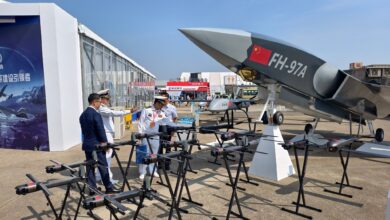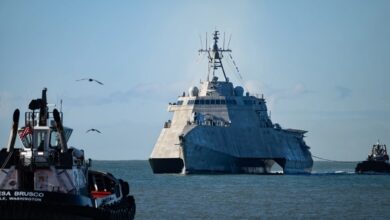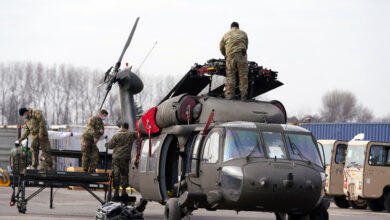China to boost defense spending by 8.1% in 2018
China announced on Monday an 8.1 percent defense budget increase for 2018, giving a boost to the modernization of the world’s largest military after spending slowed in the previous two years.
Beijing will splash out 1.11 trillion yuan ($175 billion) on its military, according to a budget report presented before the opening session of the annual National People’s Congress.
“We will stick to the Chinese path in strengthening our armed forces, advance all aspects of military training and war preparedness, and firmly and resolvedly safeguard national sovereignty, security, and development interests,” Premier Li Keqiang said in a report to the legislature.
China’s neighbors and the United States have watched warily as Beijing has modernized its military, reducing its ground troops while spending on state-of-the-art hardware and weapons.
Li said the military had completed its goal of slashing troop numbers by 300,000, leaving the People’s Liberation Army with a two-million-strong force.
At the same time, Beijing has imposed increasingly assertive claims to vast expanses of the contested South China Sea, while engaging in confrontations with Japan over disputed islands in the East China Sea and with India over Himalayan border regions.
The 2018 outlay compares with a seven percent increase last year and 7.6 percent in 2016, which marked the first time in six years that spending growth was not in double figures.
China spent $151 billion on the PLA last year, the second largest defence budget in the world but still four times less than the $603 billion U.S. outlay, according to the International Institute for Strategic Studies, a London-based think tank.
The defence budget increase has roughly kept pace with China’s national economic output in recent years. The economy grew by 6.9 percent in 2017 and the government said Monday it will target growth of around 6.5 percent in 2018.
‘World-class’ army
As the PLA marked its 90th anniversary in August, Xi warned that China will protect its sovereignty against “any people, organisation or political party.”
Since coming to power in 2012, the president has trumpeted the need to build a stronger combat-ready military, while cementing his leadership over the army, which was ordered to pledge absolute loyalty to him last year.
At a major Communist Party congress in October, Xi vowed to build a “world-class” fighting force by 2050.
In a rare address to the military earlier this year, CCTV reported that Xi ordered the creation of a new elite combat force that combines real combat training and technology.
“Create an elite and powerful force that is always ready for the fight, capable of combat and sure to win in order to fulfil the tasks bestowed by the Party and the people in the new era,” he was quoted as saying.
The PLA has stocked up on stealth fighter jets, warships and high-tech weaponry over the years. In January, Russia began deliveries of the S-400 Triumf air defense missile system to China, the first foreign government to receive the system.
More: Russia begins deliveries of S-400 to China, but isn’t transferring the technology
“Technologically speaking, the PLA has progressed markedly in recent years, with its own research and development in military hardware and growing professionalism reducing the gap with its U.S. counterpart,” Char said.
Last year, China unveiled its first domestically-built aircraft carrier, which will carry J-15 fighters that will take off from a raised “ski jump” platform. It also launched a new class of destroyer.
Its military has one operational carrier – the Liaoning – a Soviet-era vessel bought from Ukraine that was refitted and commissioned in 2012.
The chairman of the Dalian Shipbuilding Industry, which worked on both ships, said the company was “ready to build larger” carriers after gaining the experience to make more, the state-run China Daily newspaper said Friday.
Beijing took delivery of a second lot of 10 Russian Sukhoi Su-35 multirole fighter jets in December and will receive the final 10 aircraft later this year under a $2 billion 2015 deal.
China has also opened its first overseas military base in the Horn of Africa country of Djibouti.
Since 2008, its navy has participated in anti-piracy operations off the coast of Somalia and in the Gulf of Aden.
Closer to home, China has in recent years built artificial islands – some with airstrips – capable of hosting military installations in the South China Sea, inflaming tensions with its Southeast Asian neighbours.
U.S. warships, meanwhile, regularly conduct “freedom of navigation” operations near the islands to challenge China’s territorial claims.
Brunei, Malaysia, the Philippines, Vietnam and Taiwan have contested China’s claims to the sea.
China’s military budget is “disproportional in the sense that the economies of Southeast Asia do not have the resources to keep pace” and Japan’s constitution restricts military spending, said Matthew Funaiole, a fellow with the China Power Project at the Center for Strategic and International Studies in Washington.
“Whether or not this is a ‘threat’ depends on how China utilizes its capabilities. That said, its maritime presence is certainly growing.”
Smart killer robots: China’s military future could rest on artificial intelligence
With reporting from AFP












